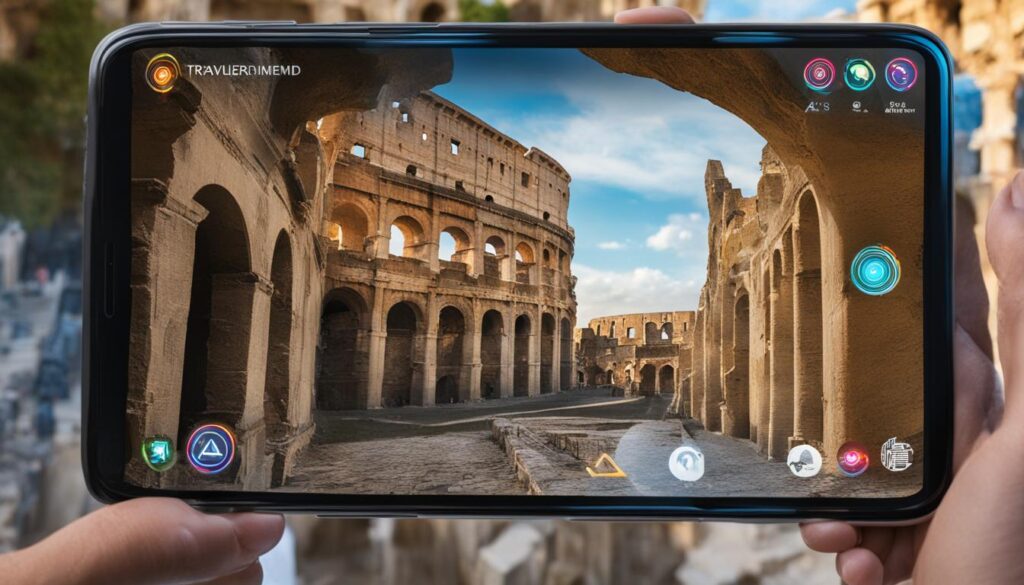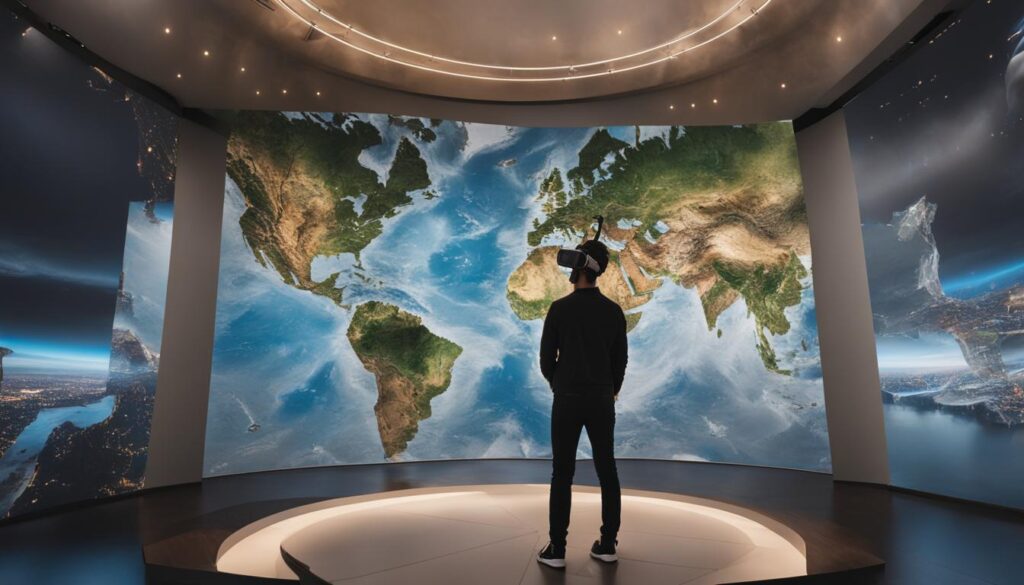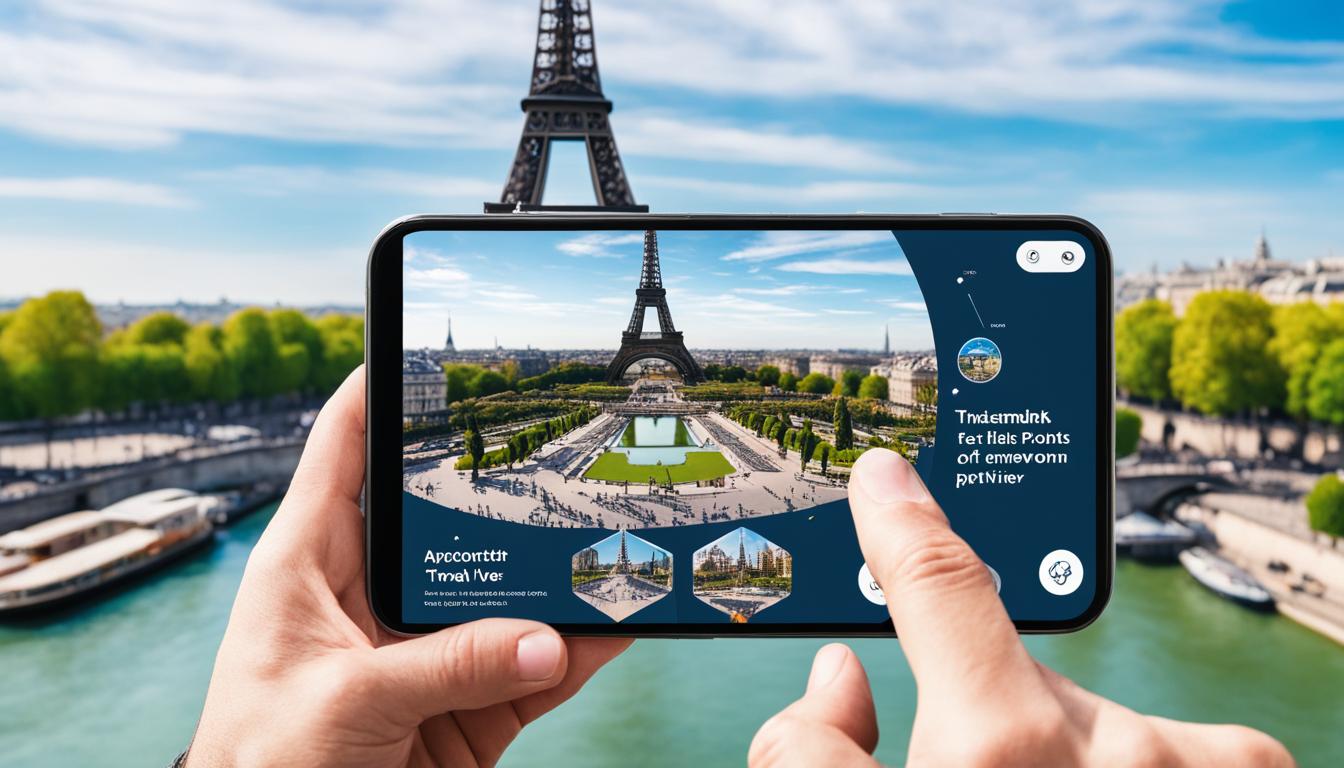Welcome to a new era of travel where you can visit other countries with augmented reality (AR). Virtual travel experiences transform how we explore the world, offering exciting possibilities and endless adventures.
With AR travel, you can enter new countries, immerse yourself in foreign cultures, and embark on unique virtual tours.
Augmented reality is a game-changer in the tourism industry, projected to reach a valuation of $23.5 billion by 2028. It offers simplified navigation and on-demand destination information and eliminates language barriers.
Whether you’re strolling through the bustling streets of Tokyo or marveling at the ancient wonders of Rome, AR provides a personalized and immersive experience like never before.
Contents
- 1 The Benefits of Augmented Reality in Travel and Tourism
- 2 Augmented Reality Applications in Travel and Tourism
- 3 Virtual Reality Travel Experiences
- 4 The Future of Augmented and Virtual Reality in Travel
- 5 Conclusion
- 6 FAQ
- 6.1 Can you visit other countries with augmented reality?
- 6.2 What is augmented reality travel?
- 6.3 How does augmented reality enhance travel and tourism?
- 6.4 What are the applications of augmented reality in travel and tourism?
- 6.5 What are virtual reality travel experiences?
- 6.6 How will augmented and virtual reality shape the future of travel?
- 7 Source Links
Key Takeaways
- AR offers simplified navigation, on-demand destination information, and language barrier elimination in tourism.
- AR enhances travel personalization, opening up new revenue streams for travel businesses.
- AR reduces operational costs in hospitality establishments and improves guest experiences.
- AR travel guides offer up-to-date background information, three-dimensional sights, and convenient navigation.
- Virtual reality (VR) provides immersive travel experiences for those unable to travel physically.
The Benefits of Augmented Reality in Travel and Tourism
Augmented reality (AR) has brought numerous benefits to the travel and tourism industry, making it more convenient and personalized for travelers.
By leveraging AR technology, the travel experience has been enhanced in various ways, from simplified navigation to immersive guest experiences.
AR in travel enables simplified navigation by providing real-time directions and a visual orientation in unfamiliar places.
With AR, travelers can easily navigate cities and tourist attractions without needing traditional maps or guidebooks. It eliminates the hassle of getting lost and allows travelers to focus more on enjoying their journey.
Also read: Will Augmented Reality Change The Way We See The World?
On-Demand Destination Information
With AR, travelers can access on-demand destination information right at their fingertips. By pointing their devices at landmarks or points of interest, they can instantly retrieve relevant information, such as historical facts, ratings, and reviews.
This empowers travelers to make well-informed decisions, ensuring they get the most out of their travel experiences.
Language Barrier Elimination
AR also helps eliminate language barriers when traveling to foreign countries. Visitors can easily understand signs, menus, and conversations through real-time translation features, regardless of spoken language. This not only enhances communication but also fosters cultural understanding and appreciation.
Travel Personalization
One of the significant advantages of AR in travel is its ability to personalize the travel experience. Through AR-powered apps, travelers can customize their itineraries, receive personalized recommendations based on their preferences, and even virtually explore accommodations before booking.
This level of personalization enhances engagement and satisfaction, ensuring that each traveler’s needs and preferences are catered to.
Also read: Best Tool for Creating Augmented Reality Experiences
Enhanced Guest Experiences
AR is transforming guest experiences at museums, art galleries, historical sites, and other attractions. It offers interactive guides, object narrations, museum maps, and a wealth of information at visitors’ fingertips.
Through AR, guests can have a more immersive and interactive experience, deepening their understanding and appreciation of the attractions they visit.
AR in travel and tourism delivers better customer service by improving communication and customer support. With AR-equipped customer service platforms, travelers can easily access assistance, seek recommendations, or resolve issues in real-time, enhancing their overall experience.
Overall, augmented reality greatly benefits the travel and tourism industry, enhancing navigation, personalization, and guest experiences.
With its ability to simplify travel, eliminate language barriers, and provide on-demand information, AR is revolutionizing how we explore the world.
Augmented Reality Applications in Travel and Tourism
Augmented reality (AR) has revolutionized how we experience travel and tourism. Its applications are diverse and offer exciting opportunities for exploration. Let’s look at how AR transforms various aspects of the travel industry.
AR Travel Guides
AR travel guides have become essential companions for modern travelers. They provide up-to-date background information on destinations and showcase three-dimensional sights, allowing you to immerse yourself in the beauty and culture of each place.
With convenient navigation features, AR travel guides make exploring new cities and countries more accessible
than ever.
AR in Hotels
Hotels are taking advantage of AR to enhance the guest experience. Interactive guides provide information about hotel amenities, local attractions, and nearby dining options.
Navigation assistance helps guests find their way around the property, while entertaining features add a touch of fun and engagement to the stay.
AR for City Tours
City tours are made even more captivating with AR technology. AR enhances architectural objects and provides historical context by altering perceptions of the surroundings.
Imagine seeing ancient ruins reconstructed through AR or witnessing historical events come to life right before you.
Real-time AR Directions
Navigating large cities can be challenging, but real-time AR directions make it a breeze. AR provides visual guidance and turn-by-turn instructions using GPS data, ensuring you never get lost. Say goodbye to physical maps and hello to a more intuitive and convenient way of finding your way around.
AR in Parks and Zoos
Parks and zoos become interactive and educational through AR experiences. Families can enjoy immersive adventures as virtual animals come to life, providing a unique learning experience for children. Explore the wonders of nature, interact with virtual exhibits, and gain a deeper understanding of the world around you.
AR for Museums
In museums, AR enhances exhibits and takes visitor engagement to new heights. Learn more about historical artifacts, view object animations, and experience pivotal historical moments through interactive displays. It’s a fusion of the past and present, bringing a new level of richness and depth to museum visits.

As AR continues to evolve, its applications in travel and tourism will only grow. AR is reshaping how we explore the world by enhancing navigation and personalization to create memorable guest experiences. Embrace the future of travel and unlock a new dimension of discovery with augmented reality.
Virtual Reality Travel Experiences
Virtual reality (VR) offers captivating travel experiences for those unable to embark on physical journeys. Through VR, companies provide virtual reality “trips” to popular destinations such as Hawaii, Rome, and Paris, offering first-class airline tickets and immersive VR tours of renowned landmarks and attractions.
With VR, you can take trial runs of various attractions, hotels, and places of interest, gaining valuable insights to make informed decisions about your future travels.
In addition to pre-travel exploration, VR enhances in-flight entertainment with immersive 360-degree experiences, allowing you to marvel at stunning landscapes and captivating narratives during your journey.
Travel agents also utilize VR to promote destinations using 360-degree videos, immersing potential travelers in the sights and sounds of their desired locations and enticing them to embark on their adventures.
While VR cannot fully replace the joy of physical travel, it plays a vital role in contributing to the recovery of the travel industry, offering a temporary escape during restrictions.
Whether you’re longing to explore new horizons or seeking solace in familiar destinations, VR provides an immersive and transcendent experience that temporarily allows you to transport yourself to different corners of the globe.

Comparison of VR and Physical Travel
| Aspects | Virtual Reality Travel | Physical Travel |
|---|---|---|
| Cost | Significantly lower costs Virtual experiences accessible to a broader audience | Higher costs Expenses include transportation, accommodation, and dining |
| Physical Presence | Immersive, but lacks tangible physical sensations | Opportunity to fully engage with the environment Interact with local culture and people |
| Personalization | Customizable experiences based on individual preferences | Freedom to explore and discover unexpected gems |
| Flexibility | Virtual exploration at any time There are no constraints on time or season | Opportunity to experience real-time events and seasonal festivities |
| Sustainability | Reduced carbon footprint It helps mitigate environmental impacts | Contributes to local economies and cultural preservation |
The Future of Augmented and Virtual Reality in Travel
The travel industry is set to witness a significant transformation with the advancements in augmented reality (AR) and virtual reality (VR) technologies.
As we look ahead, these immersive technologies hold great promise in shaping the future of travel by revolutionizing how we explore new destinations and enhancing our overall travel experiences.
Augmented reality is expected to play a crucial role in the travel industry by enhancing navigation, personalization, and guest experiences. With AR, travelers can easily navigate unfamiliar places and access valuable destination information in real time. Language barriers are no longer a hindrance, as AR can provide instant translations and make communication seamless.
Imagine walking through the streets of a foreign city with AR overlays guiding you to hidden gems, providing historical context, and even recommending local restaurants. With AR, the possibilities for personalized and immersive travel experiences are endless.
Virtual reality, on the other hand, offers a unique solution for those unable to travel physically. Post-pandemic, as travel restrictions ease and people regain confidence in traveling again, VR can continue to serve as a valuable tool. It can attract tourists by providing immersive virtual tours of destinations, allowing them to explore and experience different places from the comfort of their homes.
Travel agents can also leverage VR to offer potential travelers a glimpse into accommodations, attractions, and transportation options. By immersing themselves in virtual reality experiences, travelers can make more informed decisions and have a clearer idea of what to expect.
Furthermore, immersive VR experiences can take in-flight entertainment to new heights, making long journeys more enjoyable and comfortable. Airlines can provide passengers virtual experiences of famous landmarks and attractions, creating a unique travel ambiance onboard.
While there are certain limitations to consider, such as the need for high-priced headsets and the challenge of replicating physical sensations, AR and VR are poised to contribute significantly to the recovery of the travel industry post-pandemic.
As technology advances and becomes more accessible, we can anticipate even more innovative applications of AR and VR in travel. From virtual tourism experiences to interactive travel guides and beyond, integrating these technologies can redefine how we explore and engage with the world.

| Benefits of AR in Travel | Benefits of VR in Travel |
|---|---|
|
|
| Challenges of AR in Travel | Challenges of VR in Travel |
|
|
Conclusion
Augmented reality (AR) and virtual reality (VR) present exciting possibilities for the travel industry. With AR, you can enhance your navigation, personalize travel experiences, and overcome physical limitations. Conversely, VR allows you to immerse yourself in virtual travel experiences, exploring destinations from the comfort of your home.
These technologies will undoubtedly continue to shape the future of travel, offering unique opportunities for exploration.
As travel restrictions ease, AR and VR will play a vital role in transforming our world experience. Whether physically present in a new location or exploring virtually, these technologies will enrich your travel experiences and create new possibilities.
As we move forward, it’s clear that AR and VR will contribute to the industry’s recovery and help usher in a new era of travel. The possibilities are endless, from enhanced navigation and personalized recommendations to immersive virtual tours of exotic destinations.
So, embrace this exciting journey and get ready to embark on the next phase of travel, where augmented and virtual reality will take you to places you’ve never imagined.
FAQ
Can you visit other countries with augmented reality?
Augmented reality (AR) allows you to virtually explore and experience other countries without physically being there. Through AR travel experiences, you can visit famous landmarks, learn about different cultures, and immerse yourself in a virtual world.
What is augmented reality travel?
Augmented reality travel refers to using AR technology in the tourism industry. It enhances the travel experience by providing simplified navigation, on-demand destination information, and the elimination of language barriers. AR in travel also allows for personalization and improved guest experiences.
How does augmented reality enhance travel and tourism?
Augmented reality offers several benefits in travel and tourism. It simplifies navigation in unfamiliar places, providing real-time directions and visual orientation. AR features enhance guest experiences at museums, art galleries, historical sites, and other attractions by offering interactive guides, object narrations, and a wealth of information. It also improves communication and customer support, leading to better customer service.
What are the applications of augmented reality in travel and tourism?
Augmented reality finds applications in various aspects of travel and tourism. AR travel guides provide up-to-date background information, show three-dimensional sights, and offer convenient navigation. AR can enhance hotel experiences with interactive guides, navigation assistance, and entertaining features. In city tours, AR alters perceptions of the surroundings, enhancing architectural objects and providing historical experiences.
What are virtual reality travel experiences?
Virtual reality (VR) travel experiences provide immersive virtual tours and simulations of destinations for those unable to travel physically. Companies offer virtual reality “trips” to popular destinations, providing first-class airline tickets and VR tours of famous sights. VR allows for trial runs of attractions, hotels, and places of interest, helping travelers make informed decisions. In-flight entertainment can also be enhanced with immersive 360-degree VR experiences. Travel agents use VR to promote destinations using 360-degree videos.
How will augmented and virtual reality shape the future of travel?
Augmented reality and virtual reality are expected to play a crucial role in the future of travel. AR will continue to enhance navigation, personalization, and guest experiences, while VR will attract tourists, assist travel agents in booking accommodations, and provide immersive entertainment options during flights. Although there are limitations, such as the need for expensive headsets and limited sensations, AR and VR will contribute to the recovery and transformation of the travel industry post-pandemic.




